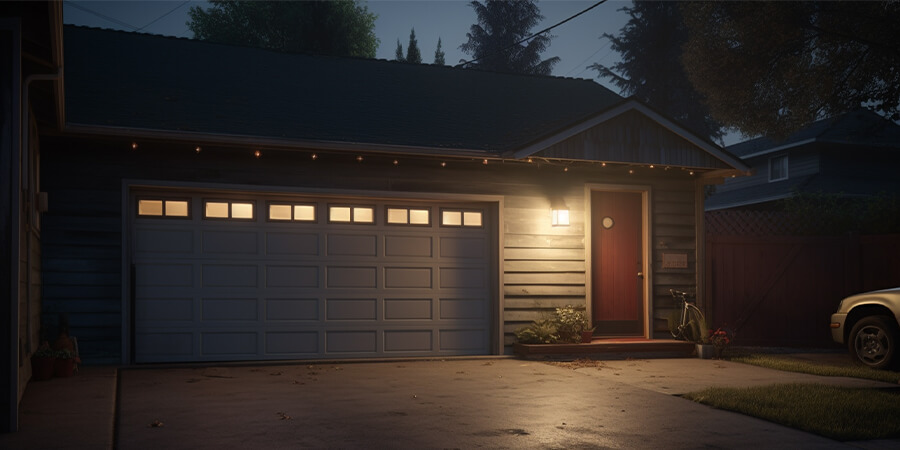How to Build Your Own Grow Room in the Garage With Tips

Garages can provide an excellent inside place to grow cannabis. First of all, there are many design options when building a grow room in a garage. Growers can treat the open area as a large grow room with multiple lights or section off a corner to grow just a few plants. You have options. Some garage grow rooms are in plain sight, and others are concealed behind false walls. Personally, nothing is cooler than a secret door.
Want to explore your options? In the following sections, we will cover the crucial details for gardeners to consider before growing cannabis in the garage.
Planning your garage grow room
What you build depends on your needs. Growers that may need to deconstruct the garden area quickly, in the case of a landlord visitation, should opt for grow tents. These can be removed and set up in less than an hour.
Have a lot of space? If only the back section of the garage is used for growing, build a false wall to conceal the garden space. However, if the plan for a garage grow room is to have multiple small cells, it’s fairly hard to hide what you are doing if someone enters the garage. The best garage grow room plan will be custom to your situation, but there are a few constants to address.
- Power: Where are the outlets? Are they all on the same circuit breaker?
- Insulation: Are the walls and ceiling insulated?
- Venting: Where and how will you exhaust grow room air?
- Grow space style: Will it be an open room, a custom build, or will grow tents be used?
- Plumbing: Is there a source of water to fill watering cans or to replenish hydroponic setups? Or will it need to be carried from inside?
Want to know how to maximize your marijuana grow with our comprehensive grow bible? Download below.
The pros and cons of growing cannabis in your garage
Advantages of growing marijuana in your garage
Building a grow room in a garage can take advantage of unused space under the roof. Most garages have concrete floors, which allows for easy cleanup of soil or liquid spills. Growing cannabis in the garage is also great for parents because it removes the grow area from the children’s area. Most garage doors can also be locked, which is a secondary method for keeping children and pets out.
Keeping an indoor marijuana grow out of the main living area makes inviting guests or family to visit less nerve-wracking. The chances of having your grow room setup discovered by someone opening the wrong door are far less when growing cannabis in the garage. When growing indoors, odor is a concern. Despite using carbon air filters, there will always be a slight plant smell in the immediate area.
Other Advantages:
- You can increase yields in a garage, thanks to a larger growing area for growing larger (longer vegetation) or more plants.
- Because of the additional headroom in garage grow rooms, HID grow lights can be a viable lighting option. The industry preference, though, is LED lighting, which is more efficient and cost-effective.
- How you build a grow room in a garage is entirely up to you, but if carpentry isn’t your forte, using marijuana grow tents is the way to go.
Disadvantages of growing marijuana in your garage
Garage grow rooms are seldom perfect from the start. Garages tend to be the coldest or the hottest place in the house, depending upon the season. That means walls will need to be insulated to maintain temperatures. You’ll likely need equipment like humidifiers, dehumidifiers, and air conditioners for greater temperature control in the garage and to help maintain proper environmental conditions.
Concrete floors can also transmit cold temperatures to the root zone in winter months, harming growth. Some garage grow room plans utilize pallets to negate this issue.
Indoor gardeners go out of their way to conceal smells from the grow room because they worry about nosy neighbors and being reported to the law. One thing that will get a garage grow noticed faster than the smell is light pouring out of the cracks in the sides of the garage door at night. You can seal your garage, but sealing a garage grow room can be tricky. Seal cracks and corners with spray foam or HVAC tape or cover them with blackout curtains, but remember, it is hard to make everything airtight. If the garage has windows, those must be carefully covered, too.
Other disadvantages:
- The potential for pest infestation increases when growing in a garage. This is especially true if a garden or other vegetation is immediately outside the garage door. If you store lawnmowers or other garden equipment in the garage, bugs can also hitch a ride on them.
- Cleanliness will be an important part of your garage grow room plans.
- Garages also often have poor air circulation, which can increase the potential for mold and mildew. Growers should be conscious of areas of stale air (particularly in corners) and rectify them using fans to increase air movement.
Tips for designing and building a grow room in your garage
Some garage grow room plans call for building walls instead of tents. Both are good options, but they have different considerations. The tips below address growers who intend to build a grow room in the garage. Remember, unlike tents, walls can’t be slid over a few feet whenever you feel like it.
Placement
Garages are where people commonly find things like water heaters, furnaces, boilers, and heating duct / HVAC systems. These items can be sources of additional heat (micro-climate), propane, and carbon monoxide gas, which can reportedly impact plant health. It is best to build your garden space away from these essential units.
As many of us aren’t certified repair folk if the hot water tank breaks and we need to call a service person out to fix it, having clear access to the tank without walking through the plant area is a plus. If the pilot light on the furnace goes out, a repair person must come out to light it. When building a grow room in a garage, place it away from essential items that may need service.
Materials
The wall boards you choose can impact your potential for mold and mildew. Choose a material that is not overly absorbent. This is important considering the often humid conditions within the grow area. Instead of general-purpose drywall, look for “green board.” It is similar to drywall but is water-resistant. Green board has a thicker paper coating, protected by a wax layer over the gypsum core.

The walls of a grow tent are reflective to direct the light energy back toward the plants, but ordinary walls aren’t nearly as effective. Paint bare walls white to increase reflectivity. There are a variety of paint brands that offer a white-colored primer with special anti-fungal properties. Take the added step against this pathogen and buy paint with these properties. In the US, KILZ and Zinsser are popular brands with added mildew and mold blockers.
Lastly, if you install a door to each grow chamber in your custom garage grow room, ensure they swing out, not inward. If the door swings into the chamber, you won’t be able to have cannabis plants in that area, which reduces the efficiency of the dedicated space. Make sure your doors open out (pulls towards you).
Electrical
Always have a licensed professional perform any electrical work. Garages are typically where you find the circuit breaker boxes, which makes a new outlet or breaker cheaper to have installed. It is possible for new outlets to be tied into an empty breaker slot or to have a new one installed to carry the electrical load from all of the grow gear.
You don’t need to tell the electrician that the higher Amp breaker or new outlets are for grow equipment. Many people use their garage as a hobby area. The addition could be for heavy-duty woodworking equipment or a kiln to fire your clay pottery. Whatever your story, make sure you know a little bit about the subject, like a model number, in case the hobby is also an interest of the electrician. Growing cannabis in the garage should be kept private; don’t offer that information to anyone.
How to control the climate and ventilation of your garage grow room
Controlling the climate is the largest challenge of building a grow room in a garage. Start by insulating the walls. Whether that means proper insulation or 4ft x 8ft (1.2m x 2.4m) foam insulation boards, this will greatly reduce temperature fluctuations.
You’ll need machinery to keep the ideal temperature and humidity levels in a garage grow room. Common machinery includes
- Humidifier
- Dehumidifier
- Air conditioning
- Heater(s)
You can ventilate your garage grow room in a few ways. Suppose you do not have close neighbors or are unconcerned with the odor post-carbon filter. In that case, you can install what looks like an extra dryer vent on the outside wall and connect the exhaust to that. However, for discreetness, there is something better.
The best way to vent your garage grow room is to run the exhaust into the attic and out of a vent in the roof. This sends any odors high in the air, making them quicker to disperse or be carried away. When drawing up garage grow room plans, be sure the walls go from floor to ceiling, unlike grow tents. This will allow you to run the exhausted air into the attic and out of the roof vent in a discreet, unseen manner.
Keeping your garage and cannabis grow room clean and safe
A clean grow room is one of the best ways to help reduce pest and pathogen levels. However, most garages have cracks and crannies where bugs and moisture can enter freely. Unfortunately, sealing your garage grow room entirely is challenging and uncommon. Plus, if you seal the garage grow room completely, you must still vent air into the space and replace CO2.
If you want to get some great deals for seeds perfect for your garage grows, please click the link below.
Be vigilant by keeping dirt, dust, and insects to a minimum. If there was a large rain storm, ensure small pools of water didn’t collect next to the tracts on the garage door. Don’t do projects in the garage with chemicals that emit odors, like paint, gasoline, oil, etc. The cannabis flowers can absorb these smells, and it will ruin the flavor and terpene profile.
Above all, keep your grow secure and safe. It is normal for houses to have security cameras and motion sensor lights mounted above the garage. Do it. This adds a layer of security without sticking out or appearing excessive. If possible, exhaust from the roof or chimney, as this makes pinpointing a source more difficult for those on the ground. Don’t talk about your garage grow room; don’t share pictures.
Final thoughts
With a little effort, your garage can become a great place to grow cannabis indoors. It’s separate from the living area, which makes it an ideal option for parents. The configurations are only limited by your imagination and resources. You don’t even have to do much prep work, either. A few major tent companies offer tents as large as a 10ft x 10ft (3m x 3m) room if the goal is to have one big sealed area.
By building your own grow room in the garage, you won’t be bothered by the frequent sounds of dehumidifiers, air conditioners, or the whir of fans. There is no lack of plans online; in fact, our article, How to set up a low-budget grow room can get you started. Not sure how much space you need for the number of plants you desire? Have a look at our article – How many plants can you grow in a grow tent to find your answer.
What has your experience been with converting garages into grow rooms? Is there something important this overview is missing? Would you prefer to grow in a garage if you could? Please let us know in the comments below. Once your grow space is set up, learn how to grow amazing cannabis for free by downloading the Marijuana Grow Bible by Robert Bergman. Then select from our award-winning genetics, and you will be set for bountiful harvests. Happy growing!



